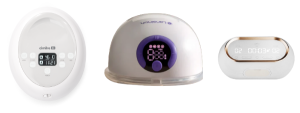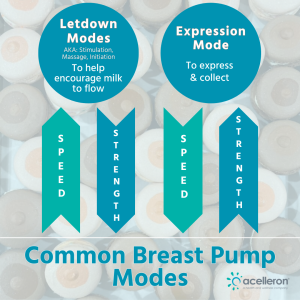Categories: Breastfeeding, Postpartum, Pumping
May 15, 2025
Last updated on May 15, 2025
How often do you read the user manual when you get a new product (e.g., cell phone, coffee maker, kid’s toy)? While some people turn to the user manual right away, many of us “wing it” when trying something new. That approach might work ok for a phone, but when it comes to breast pumps, a bit more background knowledge goes a long way – even if you’ve already pumped before. Let’s explore and understand how breast pumps operate before using it on a such a sensitive area of our body!
All breast pumps are designed to follow a general framework that aims to mimic a baby’s natural nursing pattern. Most pumps have modes, with the two most common being Letdown Mode (otherwise known as Massage Mode, Stimulation Mode, or Initiation Mode) and Expression Mode. It is recommended to start your pumping sessions in Letdown mode, which typically has a faster suck pattern with a lower suction strength to encourage milk to begin to flow. This frequent nipple stimulation and stretching from the pattern in a Letdown Mode helps your body release oxytocin – often called the love hormone – which stimulates the release of milk. Once milk flow begins, Expression Mode is then used to collect the milk with a slower suck pattern and the option of higher suction strength.
Fun fact: Oxytocin is also responsible for stimulating contractions during labor!
Terms to Consider:
- Cycle (speed)
- Measured in CPM= Cycles (or pulls) Per Minute
- Vacuum/Level (strength)
- Measured in mmHg, represented by a negative number
- Letdown/Stimulation/Massage/Initiation
- Mode or settings used to stimulate milk to begin flowing
- Expression
- Mode or settings used to express & collect milk after it begins to flow
Examples: Cimilre S6, Lansinoh DiscreetDuo and Spectra SG Portable

So, what do these terms actually mean when using a pump?
The wide variety of pump choices available allows everyone to choose a pump model that works best for their lifestyle and preferences. Whether you prefer a more user-friendly option or one with extensive customization, there are benefits to both. Pre-set pumps are often more intuitive and easier to use, while pumps with cycle speed control may have a bigger learning curve but offer more options to fine-tune settings.
Breaking Down Mode Options
- Pre-set CPM vs. CPM control
- Some pump options have their cycle speed (CPM) pre-set for each vacuum level.
- Others allow users to change the CPM independently from the vacuum level.
- The Cimilre S7 allows for both options above!
- Vacuum Levels and CPM Gaps
- Each pump has its own unique spacing – or gaps – between vacuum strength and CPM levels.
- Example: CPM may increase in increments of 5 (e.g., 60-65-70-75-80 CPM)
- Example: Suction strength (measured in mmHg) may increase in increments of 20 (e.g., 120-140-160-180 mmHg)
- Two pumps may share the same max mmHg, but the number of available levels may differ.
- Examples:
- Two pumps have a max of -280 mmHg:
- One has 8 suction strength levels to choose from
- One has 9 suction strength levels to choose from
- Two pumps have a max of -285 mmHg:
- One has 10 suction strength levels
- One has 12 suction strength levels
- As a result, the differences in suction strength between levels will vary across all of the above pumps!
- Two pumps have a max of -280 mmHg:
- Tip: Because of these variations, it is highly recommended to take it slow when trying out different speeds and strengths on a pump that is new to you!
- Examples:
- Each pump has its own unique spacing – or gaps – between vacuum strength and CPM levels.
Mode Control
Did you know it may be possible to have more than one letdown during a nursing session? Well, that is also true for pumping! While it is usually recommended to start in Letdown Mode and then switch to Expression mode, you can also start the process again if you find your milk flow has slowed down during a pumping session. This may help stimulate another significant flow of milk!
- Most pumps can go back and forth between modes, some cannot.
- Many pumps include an automatic switch from one mode to the other, after 1- 2 minutes or when they “sense” milk has started flowing.
Outside of the two most common standard modes, many manufacturers have added extra options. However, no matter how many modes your pump includes, always start with the more traditional Letdown and Expression Modes as you get to know your body (and your pump!). Once you feel confident and comfortable, you can explore the additional modes your pump offers.
Extra Mode Examples:
- 2-phase mode – Zomee Z2 & Zomee Fit
- Smart Rhythms – Elvie Pump
- Dual motor technology – Cimilre S7 and Spectra SG Portable
- 3 pumping styles in Expression mode – Lansinoh SmartPump 3.0 and Lansinoh Signature Pro
If you are ever unsure about how to use your pump or just want to feel more confident in your pumping journey, don’t hesitate to reach out to an International Board Certified Lactation Consultant (IBCLC). They’re here to support you!
You can also check out our Breast Pump Unboxing Series for a closer look at how different pumps work. These short videos walk through key features and setup tips to help you feel more prepared before your first session.



